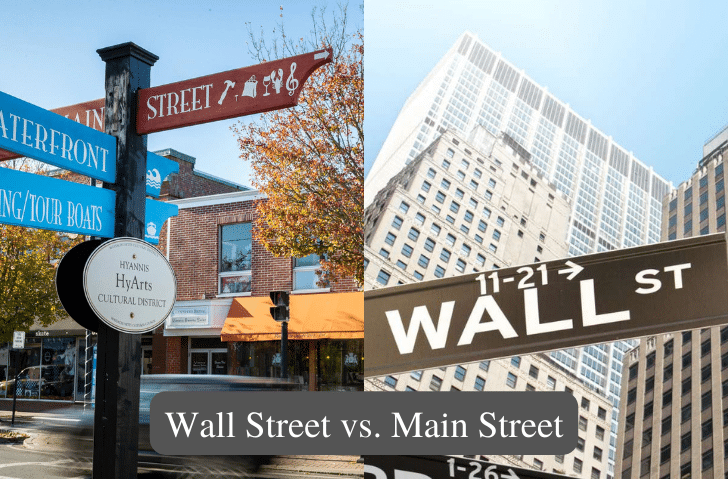In the world of finance, two distinct terms often arise: Wall Street and Main Street. These terms represent different aspects of the financial world, but they also share some similarities. Let’s delve into both the differences and similarities between Wall Street and Main Street and how they impact investors.
Wall Street: The Financial Hub

Wall Street, located in New York City’s Financial District, is often used to refer to the financial institutions and stock markets concentrated in this area. It’s like the beating heart of the financial world.
Think of Wall Street as a place where banks, investment firms, and traders gather to buy and sell stocks, bonds, and other investments. It’s a high-stakes, fast-paced environment where billions of dollars change hands daily.
Main Street: Where Regular People Live

Main Street, in contrast, represents the everyday life of regular people like you and me. It’s not a specific street but rather a symbol of the experiences and financial needs of average individuals and communities.
Main Street includes local businesses, households, and communities across the country. It’s where people work, shop, and lead their daily lives. Unlike Wall Street, Main Street is focused on meeting the needs of everyday life, not making money through investments.
Differences Between Wall Street and Main Street
- Purpose: Wall Street exists to make money through financial activities like buying and selling stocks, bonds, and other investments. Main Street, on the other hand, focuses on everyday activities and services that people need to live their lives.
- Players: Wall Street is home to big banks, hedge funds, and professional investors who manage large sums of money. Main Street consists of small businesses, families, and individuals who work hard to earn a living.
- Risk: Wall Street can be risky because investments can go up and down in value quickly. Main Street is more stable and predictable, as it involves regular expenses like paying bills and buying groceries.
- Goals: Wall Street aims to maximize profits for investors. Main Street aims to provide goods and services that meet people’s needs.
Similarities Between Wall Street and Main Street
- Economic Interdependence: While their purposes differ, Wall Street and Main Street are interdependent. A strong Main Street with thriving businesses and consumers can contribute to a healthy Wall Street, as it indicates a strong economy.
- Investment Opportunities: Both Wall Street and Main Street offer investment opportunities. You can invest in stocks and bonds through Wall Street, while Main Street provides opportunities to invest in small businesses or real estate.
- Financial Education: Understanding financial concepts and being financially literate is essential for both Wall Street and Main Street. Investors from both sides can benefit from learning about managing money wisely.
- Economic Indicators: Economic indicators, such as inflation and employment rates, impact both Wall Street and Main Street. These indicators can affect investment decisions and consumer spending.
Implications for Investors
Understanding the differences and similarities between Wall Street and Main Street is crucial for investors:
- Diversify Investments: Consider diversifying your portfolio with investments from both Wall Street and Main Street to spread risk.
- Long-Term Perspective: Think long-term when making investment decisions, as it benefits both Wall Street and Main Street investors.
- Economic Awareness: Pay attention to economic indicators that affect both sides, as they can have a significant impact on your investments.
- Stay Informed: Keep yourself informed about developments on both Wall Street and Main Street to make informed investment choices.
- Advocate for Balance: Recognize the importance of a balanced approach that considers the interests of both sides. Encourage responsible and ethical business practices.
In conclusion, Wall Street and Main Street have distinct purposes and players, but they also share similarities in their economic interdependence and investment opportunities. Understanding these dynamics can help investors navigate the complex financial landscape more effectively and ethically.
Are you using Wall Street is an investment vehicle or as a Casino? Let’s take a deep dive and contact me.

